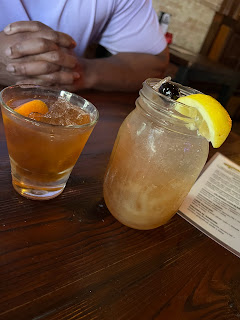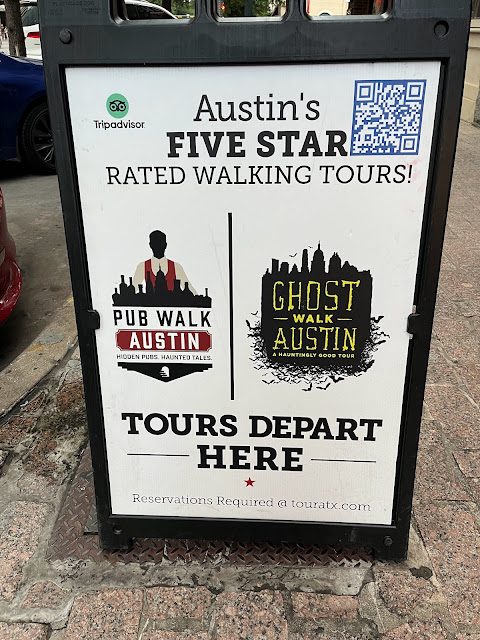After recharging, we were hungry again. Having such great luck with the food this morning, we asked google for a food truck recommendation on the way to our tour, The first thing to pop up was Sabor Venezolano
We went with the recommendations of the proprietor and had Tequenos with guasacaca (Venezuelan avocado-based sauce). I'd compare these to mozzarella sticks, but better.
Cachapa is a thin pancake made with ground fresh corn, cheese, and panela (or sugar), cooked in a budare (a clay or iron plate). It is then served with queso de mano (Venezuelan fresh cheese) and butter.
This has made Karl and I search to see if we can find a Venezuelan restaurant in St. Louis. Stupid good.
And Empanadas. These were good as well. We probably should have eaten these first because we REALLY liked the pancake. LOL
Spaghetti Warehouse Building
117 West Fourth Street, Austin, TX 78701 The Austin location was the third location in the chain's history, now houses the "Capitol Grille" and "Parker Jazz Club". Built in 1902, it used to be a grocery warehouse, and during prohibition, was a brothel. Every night the sound of merriment, and the occasional sounds of fighting and even death, reverberated from the walls until the morning light made the operators return to discretion. While no reported deaths in the building are in record, the old warehouse had seen more than its fair share of tragedy. Former employees of the Spaghetti Warehouse report a variety of strange events taking place on the second floor. Specifically, lights would flicker on and off and strange noises came from the employee break room. The basement of the Spaghetti Warehouse apparently also makes the employees a bit edgy. They also reported an eerie feeling as though they are being watched. A young blonde boy, between the age of 8 and 10 runs through the building after hours and is mostly seen where the moderns bathrooms now stand. His identity is unknown, but it’s assumed that he was the child of one of the prostitutes who lived in the old warehouse.On July 23, 1916, the Austin Fire Department fought its first major fire in the Kreisle Building at Congress and 4th. The building was a total loss. Also lost were the lives of two women unable to escape their elevator cage. Slamming doors and blood-curdling screams have been heard, accompanied by the sound of running up and down the 59-step staircase—perhaps the ancient cries and footfalls of valiant firefighter James “Jimmy” Glass, whose spine was crushed inside the burning building. Would you like to take a guess at his badge number? A most unlucky 13. The Kreisle Building was rebuilt and is now home to Speakeasy Austin. During a recent renovation, workers complained that their tools and supplies were shuffled around the spooky speakeasy. Several people claim to have seen a woman’s apparition in the antique elevator—the only item that survived the fire—now located inside Speakeasy Austin’s swanky prohibition era vibe Kabaret Room.
Texas Capitol
The Haunting Legend of the Littlefield House
The Legend of Littlefield House begins with George and Alice
Littlefield, a loving couple who were universally adored throughout Austin.
No one knew that
George had a secret.
Unable to have
children of their own, George and Alice doted on their twelve nephews and
seventeen nieces. When George built his mansion, he intended to house as many
children as he could.
He and Alice even
paid for all twenty-nine college educations at the University of Texas at
Austin. You could say that George and Alice were adored by their family
members.
They didn’t know
that each time George went on an errand or a trip, he locked his wife in the
attic. He feared that the Yankees might swarm in and kidnap her, leading him to
bolt the attic door with Alice inside.
As you’d expect, Alice
began to experience fits of hysteria.
She lived in terror
that she might be stolen away from George, or worse – brutally murdered. On
more than one occasion, Alice could be seen hurrying down the stairs. Her
horrifying screams could be heard echoing throughout the mansion.
George had little
idea about what to do with his wife. He brought her to one doctor after
another, until one advised him to take Alice to a sanitarium.
George refused.
Instead, he hired three nurses whose sole job was to comfort and care for his
beloved Alice. (Wait, didn’t this guy lock his wife in an attic?)
As the legend goes,
George Littlefield died of pneumonia in 1920. While Alice remained heartbroken,
her mental condition began to improve after some time.
She regained her
zest for life and attended parties hosted by friends and family. When she died
at the age of 88, Alice bequeathed her home to the University of Texas.
She was buried in Austin’s
Oakwood Cemetery beside her beloved husband.
The Phantom Piano Player
The most common paranormal phenomena known to occur at the Littlefield House is the haunting sounds of the piano playing upstairs. As Alice Littlefield was the one who played it most frequently during life, it makes sense that her spirit continues doing so in the afterlife.
**Please note, The story above relates to the family home below. It has nothing to do with the building she pointed out. 
Driskill Hotel
Room 525
THE TALE
Two jilted lovers, separated by a century of history, roam The Driskill’s halls.
THE DETAILS
Like Stephen King’s infamous Room 217 in The Shining (changed to 237 in the Kubrick film), The Driskill has its own haunted suite where tragedy keeps repeating itself. Little is known of the first dead bride, a sort of ancillary ghost peppered in for flavor. The only thing confirmed is that she killed herself in Room 525 after her fiancé called off their wedding, and that she mournfully walks the halls in her Victorian gown.
The second bride is the more famous one, in part because she is a rare Gen X ghost who died in 1991—yet she still fits the trope of a young and beautiful woman who meets a terrible end.
A Houston socialite who escaped to the hotel after being jilted at the altar, she went on a massive shopping spree with her lover’s purloined credit card and was last seen carrying several bags into Room 525. Later that night, while sitting in the bathtub, the bride put a gun in one hand and a pillow in the other, then shot herself. Since then, Driskill guests have claimed to see her carrying packages or a pistol down the hall before she vanishes into Room 525 without ever opening the door.
The Senator’s Daughter
THE TALE
A child meets an untimely end and continues to play among some of the hotel’s most storied features.
THE DETAILS
Edgar Allan Poe once said, “Of all melancholy topics…the death of a beautiful woman is un- questionably the most poetical topic in the world…” He built a legacy on the backs of dead brides, much like ghost tour companies, podcasters, and writers that specialize in Austin’s tales of the macabre. But when it comes to gothic tropes, nothing competes with a ghost bride quite like a ghost child.
Legend says that a girl, rumored to be named Samantha Houston, tripped and fell to her death on the Driskill’s grand staircase and can since be heard giggling and bouncing a ball on its steps. Historians have long searched for any evidence to verify the tale, all to no avail. Considering the public setting and the headline-grabbing implications of the story, it seems to point to the apocryphal—even if some supernatural ball continues dribbling down the hotel’s staircase and into our nightmares.

Annie Lennox’s Ghost
THE TALE
The spirit of a suave Texas cowboy haunts traveling female rock stars.
THE DETAILS
The Driskill has been smoke-free for more than a decade, but that hasn’t deterred pockets of cigar smoke from being detected by unsuspecting guests. Some blame the hotel’s founder, Col. Jesse Driskill, who was known to frequently partake of a good stogie. Regardless, one cigar-wielding male ghost dressed in 19th-century cowboy clothing has appeared before many a female musician. Annie Lennox claimed he selected her stage outfit while she showered, and Johnette Napolitano of Concrete Blonde wrote the song “Ghost of a Texas Ladies Man” after a night of enduring his ghostly shenanigans. He’s also been known to touch women on the arm or back, proving himself more worthy of a historical romance than a gothic novel.
Here is a tour from the ATX TV Festival: https://youtu.be/9yg7TGaQYoY This guide actually knew what she was talking about. LOL
In 1884, a string of gruesome murders terrorized the people of Austin, Texas. Three years before Jack the Ripper struck London, a killer—or possibly multiple killers—brutally attacked and murdered eight women in their beds. The heinous crimes stopped as abruptly as they began, and the slayings have remained unsolved for over a century.
Could this be one of the first known serial murders in the United States? Why were those responsible never brought to justice? Six of the eight victims were African American—were the crimes racially motivated?
Armed with modern forensics, the History Detectives interview descendants of the murdered women and enlist the help of modern-day experts in an effort to solve this historical whodunit. Can they finally crack the case?
According to Texas Monthly, the killer murdered seven women (five black, two white) and one black man. Additionally, the killer seriously injured six women and two men.[8]
All the victims were attacked indoors while asleep in their beds. Five of the women were dragged, unconscious but still alive, and killed outdoors. Three of the women were severely mutilated while outdoors.
All the victims were posed in a similar manner. Six of the murdered women had a "sharp object" inserted into their ears.[9]
The series of murders ended with the killing of two white women, Eula Phillips, age 17, and Susan Hancock, who was attacked while sleeping in the bed of her 16-year-old daughter on the night of 24 December 1885.[1]
Only one of those arrested, James Phillips, was convicted. He was found guilty of murdering his wife but the conviction was later overturned.[1]
London authorities questioned several American cowboys, one of whom (according to the authors of Jack the Ripper, A to Z) was possibly Buck Taylor, a performer in Buffalo Bill's Wild West Show.[10] Taylor was born in Fredericksburg, Texas,[11] about 70 miles west of Austin.
According to a front-page article in The New York Times of December 26, 1885, 400 men were arrested during the course of the year.[6] According to the Texas Monthly, powerful elected officials refused to believe that one man, or one group of men, was responsible for all the murders.
The African-American community and some practitioners of voodoo believed the killer was a white man who had magic powers that enabled him to become invisible, as no dogs outside or in fenced-yards adjacent to locations where murders occurred were heard to bark or raise any alarm.[1]
The series of murders stopped when additional police officers were hired, rewards were offered and citizens formed a vigilance committee to patrol the streets at night.[12] Contemporary newspapers reported that the murderer(s) had apparently fled the area, as no more murders were officially attributed to the killer by the authorities.[1]
The BS our tour guide gave us was someone named Maurice and she grabbed pieces of the "missing toe" of Nathaniel Elgin and the mention of Buck Taylor being a cowboy from Austin that the authorities were questioning as a possible Jack the Ripper - and wrapped it all into Maurice. She said Maurice lived where this Residence Inn stands now. All BS. Who the hell is Maurice?
So, as much as I *LOVE* a good ghost tour, even if I don't see anything creepy, this was just a waste of time. She clearly didn't actually know Austin history???

































No comments:
Post a Comment